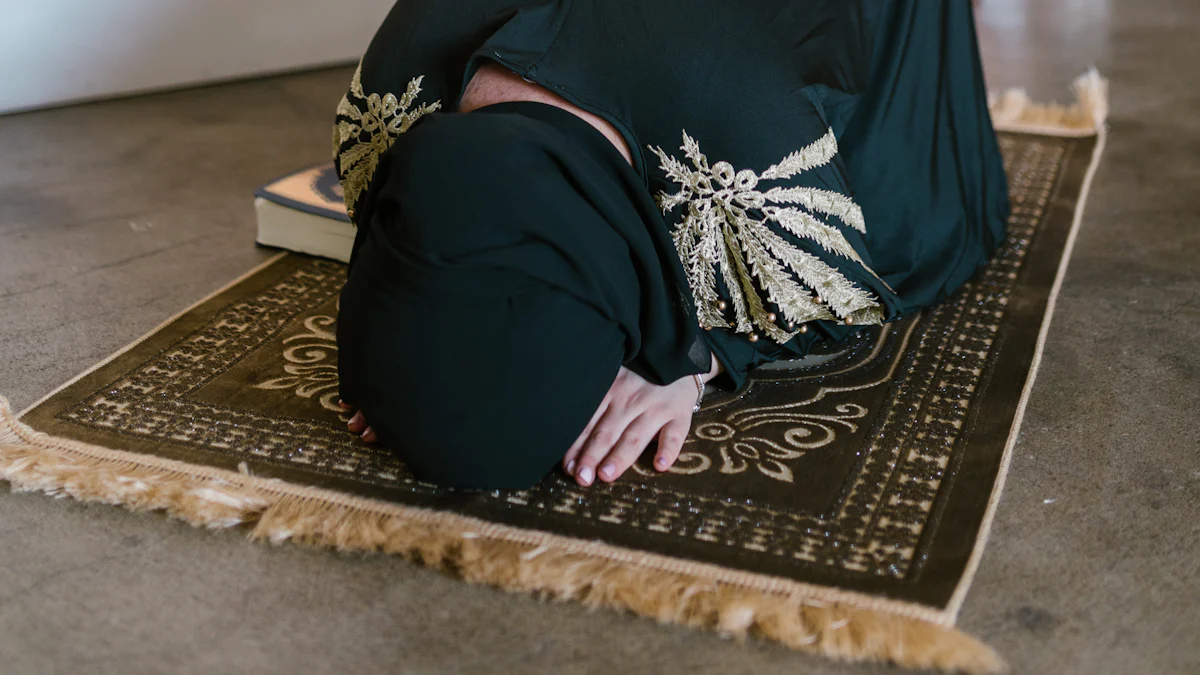如何帶著專注和專注地祈禱

Prayer holds immense importance in your daily life. It nurtures your emotional well-being and strengthens your sense of purpose. However, maintaining focus during prayer can be challenging. You might find your mind wandering or struggling to connect deeply. To overcome these hurdles, you need to pray with intention. This approach helps you stay centered and enhances your spiritual connection. By setting clear intentions, you create a meaningful prayer experience that aligns with your heart's desires and spiritual goals. Embrace this practice to transform your prayer life and find peace and clarity.
Understanding the Concept of Intentional Prayer

Defining Intention in Prayer
Prayer becomes transformative when you pray with intention. This means focusing on the purpose behind your words and actions. When you understand the role of purpose in prayer, you align your heart with your spiritual goals. This alignment creates a deeper connection with the divine.
The Role of Purpose in Prayer
Purpose gives your prayer direction. Instead of reciting words out of habit, you engage with your true desires and needs. This engagement helps you stay present and connected. You find clarity and peace when your prayers reflect your genuine intentions.
Differentiating Between Routine and Intentional Prayer
Routine prayer often lacks depth. It can feel mechanical and disconnected. In contrast, intentional prayer involves mindfulness and focus. You actively participate, seeking a meaningful experience. This shift from routine to intentionality enriches your spiritual journey.
Biblical References on Intentional Prayer
The Bible offers profound insights into praying with intention. These stories and teachings guide you in cultivating a purposeful prayer life.
Examples from the Bible
Consider Nehemiah, who prayed with intention by focusing on God's promises. He sought guidance and wisdom for his journey. His example shows how intentional prayer can lead to powerful outcomes. The early church also relied on prayer before significant events, emphasizing its importance in spiritual growth.
Lessons from St. John Paul II
St. John Paul II taught that prayer should be a dialogue with God. He encouraged believers to listen and reflect during prayer. This approach fosters a deeper connection and understanding. By following his teachings, you can enhance your prayer life and find inspiration in your spiritual practice.
How to Pray with Intention
Preparing for Intentional Prayer
To pray with intention, start by preparing your environment. A peaceful space can enhance your focus and connection.
Creating a Conducive Environment
Choose a quiet spot where you feel comfortable. This could be a corner in your room or a serene outdoor location. Remove distractions like electronic devices. Consider using soft lighting or lighting a candle to create a calming atmosphere. These small changes can help you center your thoughts and open your heart to prayer.
Setting Clear Intentions
Before you begin, take a moment to reflect on your purpose. What do you hope to achieve through this prayer? Setting clear intentions aligns your heart with your spiritual goals. Write down your intentions if it helps you focus. This clarity transforms your prayer into a meaningful dialogue with the divine.
Techniques to Enhance Focus
Enhancing focus during prayer requires mindfulness and the use of aids that keep you present.
Mindfulness Practices
Incorporate mindfulness into your prayer routine. Focus on your breathing. Take deep breaths to calm your mind. A study in Frontiers in Psychology found that a daily 10-minute 'centering prayer' meditation significantly reduced stress. This practice can bring peace and clarity, helping you pray with intention.
Using Prayer Aids
Prayer aids can guide your focus. Consider using a journal to jot down thoughts and reflections. This practice not only keeps you engaged but also allows you to track your spiritual journey. Some people find comfort in holding a rosary or prayer beads. These tools can serve as physical reminders of your intentions, keeping your mind and heart aligned.
By incorporating these practices, you can transform your prayer experience. You will find that when you pray with intention, your connection deepens, and your spiritual journey becomes more fulfilling.
Overcoming Challenges in Focused Prayer
Addressing Common Distractions
Distractions can easily disrupt your prayer time. Identifying and managing these distractions is crucial for maintaining focus.
Internal Distractions
Your mind often wanders during prayer. Thoughts about daily tasks, worries, or future plans can intrude. To combat this, practice mindfulness. Focus on your breathing. Take deep breaths to calm your mind. This technique helps you stay present. Consistent prayer also reduces internal noise. As one person shared, "Consistency in my prayer life is a constant struggle for me. I find the noise inside my head becomes louder the less consistent I am about prayer." By praying regularly, you can quiet your mind and enhance your focus.
External Distractions
External distractions, like noise or electronic devices, can interrupt your prayer. Create a distraction-free environment. Choose a quiet spot. Put your phone out of reach. One individual noted, "I actually have to put my phone out of arm’s reach when I pray so I’m not distracted." Protect your prayer time. The Lord deserves your undivided attention. By minimizing external distractions, you can deepen your connection with the divine.
Balancing Structure and Spontaneity
Finding the right balance between structured and spontaneous prayer can enhance your spiritual practice.
Structured Prayer Routines
Structured prayer routines provide consistency. They help you establish a regular prayer habit. Set specific times for prayer. This routine creates a rhythm in your spiritual life. It allows you to offer your work and worries to God. As one person reflected, "Taking the time to offer my work to God takes the heavy pressure and the relentless drive off my heart and replaces them with a feeling of abundance and grace."
Allowing for Spontaneous Prayer Moments
While structure is important, spontaneity adds depth to your prayer life. Allow yourself moments of spontaneous prayer. These moments can occur anytime, anywhere. They enable you to express gratitude and listen for guidance. One individual shared, "Praying is more than just giving my demands, but also about being thankful and listening." Embrace these spontaneous moments. They enrich your spiritual journey and foster a deeper connection with God.
By addressing distractions and balancing structure with spontaneity, you can overcome challenges in focused prayer. This approach transforms your prayer experience, allowing you to connect more deeply with your spiritual self and the divine.
Incorporating Intentional Prayer into Daily Life

Incorporating intentional prayer into your daily routine can transform your spiritual journey. By establishing a consistent practice, you create a foundation that supports your emotional and spiritual well-being.
Establishing a Routine
Creating a routine helps you pray with intention consistently. It anchors your day and provides a sense of stability.
Setting Specific Prayer Times
Choose specific times for prayer each day. Morning and evening are ideal moments to connect with the divine. Starting and ending your day with prayer sets a positive tone. As one anonymous Catholic woman shared, daily prayer helps keep things in perspective. Problems seem less overwhelming, and you find peace and encouragement in your daily tasks.
Integrating Prayer into Daily Activities
Prayer doesn't have to be confined to a specific time. Integrate it into your daily activities. Offer a quick prayer of gratitude while commuting or before meals. These small moments help you maintain a continuous connection with your spiritual self. They remind you to pray with intention throughout the day.
Reflecting on Prayer Experiences
Reflecting on your prayer experiences deepens your understanding and enhances your spiritual growth.
Keeping a Prayer Journal
A prayer journal is a valuable tool for reflection. Write down your thoughts, intentions, and experiences. This practice helps you track your spiritual journey and see how your prayers evolve. It encourages you to pray with intention by focusing on your true desires and needs.
Sharing Experiences with a Community
Sharing your prayer experiences with a community can provide support and inspiration. Join a prayer group or discuss your journey with friends. These interactions offer new perspectives and strengthen your resolve to pray with intention. You find encouragement and motivation in the shared experiences of others.
By establishing a routine and reflecting on your experiences, you can incorporate intentional prayer into your daily life. This practice enriches your spiritual journey and brings peace and clarity to your everyday existence.
Embrace the practice of intentional and focused prayer. It transforms your spiritual journey, offering emotional comfort and reducing stress. By praying with purpose, you connect deeply with your spiritual self and find clarity. This connection nurtures your well-being and strengthens your sense of purpose. Remember, prayer is a powerful way to seek guidance and support. Maintain this spiritual connection to enrich your life and foster a sense of peace and security. Let your prayers be a source of strength and inspiration as you navigate life's challenges.
